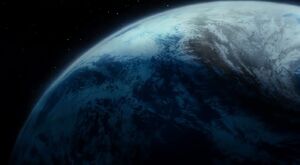| ||||||||||||||||||||||||||
| [Source] | ||||||||||||||||||||||||||
Earth is the homeworld of the human species and the third planet in the Solar System.
Geographical Features[]
As the homeworld of the human species, Earth is the archetype by which they measure all other planets in terms of habitability. The ultimate goal of all terraforming efforts across the Milky Way Galaxy is to create an environment similar to that of Earth.
Earth is approximately 4.5 billion years old. It possesses an iron core that is solid at its center with a liquid layer encompassing it. This generates a powerful magnetosphere that has kept Earth from losing its water and other volatile organic compounds. The core is surrounded by semifluid magma, on which the solid, yet light crust floats. The planet is geologically active, with plate tectonics causing volcanoes and natural springs to dot its surface. Earthquakes are common.
The planet lies in the liquid water zone of Sol, and water is found in abundance - oceans cover 70% of the planet. The 30% of the surface that is dry land is divided amongst four major landmasses (which Humans divide into seven continents) and thousands of islands spread across the oceans. There is a thin atmosphere that is maintained by the biomass on the planet's surface. It is 78% nitrogen and 21% oxygen, with the remainder a mix of trace gases including argon, carbon dioxide, and water vapor.
Earth spins on its axis once every 23 hours, 56 minutes, 4 seconds. The axis is tilted 23° from its orbital plane, which causes seasonal changes in its higher latitudes as it orbits Sol.
Earth held an abundance of natural resources well into the 22nd century, such as minerals and several substances produced as by-products by the planet's biomass, such as petroleum, coal, wood, and natural gas. Humans utilized these resources to create an impressive technology base. However, over time the resources of Earth began to become exhausted, prompting Humans to search for other worlds which could be exploited.
Terrain and Climate[]
The geological activity of Earth has created a wide variety of terrain across its surface. Plate tectonics and erosion (by both the atmosphere and water) dominate the formation processes of surface features. There are mountain ranges, valleys, plains, mesas, and canyons, which in turn may be found in deserts, tundra, forests, grasslands, and icecaps at the poles. Earth may be classified into three general climate zones: the tropics, which straddle each side of the Equator, the polar regions located around the North and South Poles, and the temperate zones in-between. Each of these are divided into other zones which vary depending on the distance from the Equator, proximity to large bodies of water, and local geography, such as mountains.
Humans began to modify the terrain of Earth when they discovered agriculture around 8000 BCE. This enabled the development of great cities linked by trade routes stretching for thousands of miles over both land and ocean. Beginning in the 19th century, Humans began to alter the planetary climate with the introduction of industrial by-products. By the 24th century, much of Earth had become an arid wasteland.

